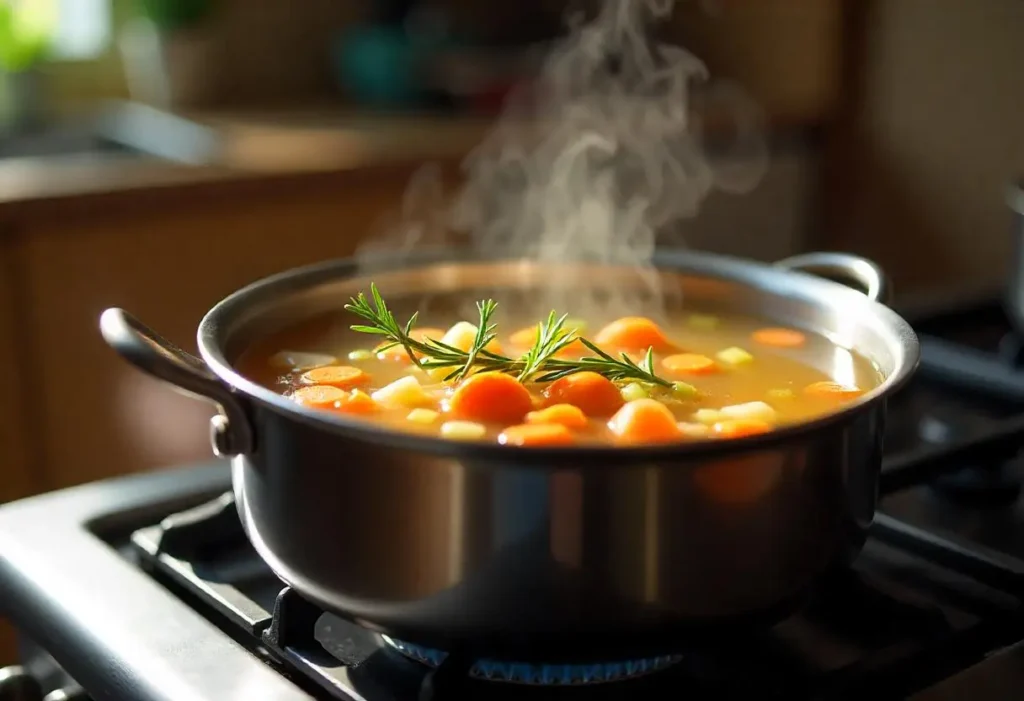Introduction: Why Learn How to Make Chicken Bone Broth?
If you’ve ever wondered how to make chicken bone broth at home, you’ve likely already heard about its rich flavour, nutrient density, and versatility in the kitchen. Homemade chicken bone broth isn’t just another trendy culinary project—it’s a timeless staple that can elevate your soups, sauces, gravies, and even healthy beverages. Following a few simple steps, you can transform humble chicken bones into a luxurious base brimming with health benefits and complex flavour profiles.
Table of contents

In this detailed guide, we’ll show you exactly how to make chicken bone broth that’s both delicious and nourishing. You’ll learn what sets bone broth apart from simple stock, discover key tips for extracting the maximum nutrients, and find creative ways to incorporate it into your meals. Let’s dive right in.
What Is Chicken Bone Broth and How Is It Different from Stock?
While the terms “bone broth” and “stock” are often used interchangeably, a few nuances set them apart. Traditional chicken stock typically simmers for a shorter period, anywhere from 2 to 4 hours. This method extracts flavors but does not always provide the full depth of nutrients from longer cooking times. On the other hand, chicken bone broth is gently simmered for a much longer stretch—often 12 to 24 hours or more. This extended cooking time allows the collagen, gelatin, and minerals to fully release into the Broth, resulting in a thicker consistency and richer mouthfeel.
Key Differences:
- Cooking Time: Stock = shorter simmer; Bone Broth = long, slow simmer.
- Nutrient Density: Bone broth has higher collagen levels, amino acids, and minerals.
- Flavour and Texture: Bone broth is often more gelatinous when cooled, offering a richer taste and mouthfeel.
If you want the health benefits and the unparalleled depth of flavour, learning how to make chicken bone broth is a worthwhile skill you can master right in your kitchen.
The Health Benefits of Homemade Chicken Bone Broth
Bone broth isn’t just a culinary building block—it’s packed with nutrients that can support overall health. While more scientific research is needed to substantiate all the health claims, many people find that consuming homemade chicken bone broth regularly supports digestion, joint health, and general well-being.
Potential Health Benefits:
- Rich in Collagen and Gelatin: These proteins help support joint health and may improve skin elasticity.
- A Good Source of Minerals: Long-simmered bones release calcium, magnesium, phosphorus, and other trace minerals.
- Supports Gut Health: The gelatin in bone broth may help soothe the lining of the digestive tract.
- Immune System Support: A warm, nutrient-rich broth can help support your body during cold and flu seasons.
Essential Ingredients and Tools You’ll Need
Before making chicken bone broth, gather the right ingredients and tools. The quality of what you put in directly affects what you’ll get out, so opt for high-quality bones and produce whenever possible.
Ingredients
- Chicken Bones: Use bones from a whole roasted chicken or raw carcasses and backs. Organic, pasture-raised chickens often yield a better flavour and higher nutrient content.
- Aromatics: Onions, carrots, celery, garlic, and fresh herbs like thyme, parsley, or bay leaves.
- Apple Cider Vinegar (ACV): A splash of ACV helps draw minerals out of the bones and improves nutrient extraction.
- Filtered Water: Clean, neutral-tasting water ensures a pure flavour.

Tools
- Large Stockpot or Dutch Oven: A sturdy pot to hold bones and water, preferably with a heavy bottom for even heat distribution.
- Fine-Mesh Strainer: To remove impurities and ensure a clear broth.
- Large Spoon or Ladle: For skimming foam and transferring the Broth.
- Storage Containers: Glass jars or BPA-free containers with tight lids.
- Optional: A slow or pressure cooker if you prefer a hands-off approach.
Step-by-Step Instructions: How to Make Chicken Bone Broth
Now that your ingredients and tools are ready, let’s break down the process. By following these instructions, you’ll learn how to make flavour-packed chicken bone broth, nutrient-rich, and incredibly versatile.
Step 1: Selecting High-Quality Chicken Bones
Your Broth is only as good as the bones you start with. Choose bones from a quality source for the best flavour and nutrient density. If you’re using a leftover roast chicken, save the carcass and any wings or legs that weren’t fully stripped of meat. You can also ask your local butcher for chicken backs, necks, and feet, which are rich in collagen.
- Try to use a combination of bones for a balanced flavour.
- Consider adding chicken feet if available, as they’re high in collagen and improve the Broth’s gelatinous consistency.
Step 2: Pre-Roasting the Bones for Deeper Flavor
While not strictly necessary, roasting the bones in the oven before simmering can greatly enhance the depth of flavour in your Broth. Preheat the oven to 400°F (204°C). Spread the bones on a roasting pan and roast for about 30-45 minutes or until they’re nicely browned but not burned. This step adds complexity and a subtle sweetness to your final Broth.
- Turn the bones halfway through roasting for even browning.
Step 3: Adding Aromatics and Vegetables
Transfer the roasted bones to your stockpot and add your aromatics. Include chopped onions, carrots, and celery. A few garlic cloves and sprigs of fresh herbs like thyme or parsley can elevate the taste. Add one to two tablespoons of apple cider vinegar to help extract minerals.
Suggested Aromatics:
- 1 large onion, quartered
- 2 medium carrots, roughly chopped
- 2 celery stalks, cut into pieces
- 2-3 garlic cloves, smashed
- A handful of fresh parsley sprigs
- 1-2 bay leaves
- A few sprigs of fresh thyme
- Avoid adding starchy vegetables like potatoes; they can make the Broth cloudy.
Step 4: Simmering for Maximum Nutrient Extraction
Cover the bones and vegetables with filtered water. Bring the pot to a gentle simmer over medium heat, then reduce the heat to low. The goal is a gentle simmer—tiny bubbles occasionally breaking the surface. Skim off any foam that rises during the first hour to keep your Broth clear.

Recommended Simmer Times:
- Minimum: 12 hours
- Ideal: 18-24 hours
- Extended: Up to 48 hours for maximum nutrient extraction
Keep an eye on the water level and add more if it evaporates too quickly. The longer you simmer, the richer and more gelatinous your Broth will become.
Step 5: Straining and Storing Your Bone Broth
Once you’ve simmered to your satisfaction, turn off the heat and let the Broth cool slightly. Strain it through a fine-mesh sieve into a clean bowl or pot. Discard the solids—most flavour and nutrients have already leached into the liquid.
Allow the Broth to cool to room temperature before transferring it to airtight containers. Store in the refrigerator for up to 5 days or freeze it in portions for 3-6 months.
- Use wide-mouth mason jars or BPA-free containers.
- Freeze in ice cube trays for easy portioning.
Tips for Achieving the Perfect Texture and Flavor
- Use High-Quality Ingredients: Opt for organic, pasture-raised chicken bones and fresh, organic vegetables.
- Don’t Rush the Simmer: Patience pays off. The longer you simmer, the richer the result.
- Adjust Seasoning After Cooking: Adding salt after the Broth has finished simmering is best. This allows you to control the final saltiness more precisely.
- Add a Splash of ACV: Apple cider vinegar helps extract bone minerals.
- Watch the Heat: Avoid vigorous boiling, producing a cloudy broth and a less delicate flavour.
Common Mistakes to Avoid
- Boiling Instead of Simmering: A rolling boil emulsifies fats and produces a cloudy broth. Keep the heat low and steady.
- Skipping the Skimming: Removing foam and impurities ensures a cleaner, clearer broth.
- Not Using Enough Bones: A few bones won’t produce a rich broth. Be generous with your bone-to-water ratio.
- Neglecting Proper Storage: Always store in airtight containers and use within recommended time frames.
- Over-Seasoning at the Start: Salt intensifies as Broth reduces. Season lightly during cooking and adjust before serving.
Creative Ways to Use Your Chicken Bone Broth
Your freshly made chicken bone broth can serve as a foundation for countless dishes, enhancing both flavor and nutrition. Here are a few inspiring ideas:
- Soups and Stews: Use it as a base for chicken soup, minestrone, or a hearty beef stew.
- Sauces and Gravies: Deglaze pans and reduce bone broth into silky sauces.
- Cook Grains: Replace water with bone broth when cooking rice, quinoa, or couscous to add more flavor and nutrients.
- Ramen and Pho: Craft a delicious homemade ramen or pho broth by infusing bone broth with traditional Asian aromatics.
- Rich and Creamy Casseroles: Pair your broth with dishes like Chicken Divan with Sherry and Parmesan for an indulgent, easy-to-make meal.
Frequently Asked Questions
1. Can I use raw bones, or must they be roasted first?
You can use raw bones, but roasting them first adds depth of flavour. Raw bones will still produce a nutritious broth if you’re short on time.
2. What’s the difference between chicken bone broth and chicken stock?
Chicken bone broth is simmered longer, extracting more collagen and minerals. Chicken stock is simmered for a shorter period, focusing more on flavour than nutrient density.
3. How long can I store my chicken bone broth?
Refrigerate for up to 5 days or freeze for 3-6 months. Always use airtight containers and label them with the date.
4. Can I add other seasonings like ginger or turmeric?
Absolutely. Feel free to experiment with additional aromatics, spices, and herbs that complement your intended dishes.
5. Why is my bone broth not gelatinous?
If your Broth doesn’t gel when cooled, it may be because there weren’t enough collagen-rich bones or simmered long enough. Adding chicken feet or simmering longer should help.
Conclusion: Ready to Make Your Chicken Bone Broth?
Now that you know how to make chicken bone broth, you can transform simple kitchen scraps into a culinary powerhouse. Whether whipping up a comforting soup, creating a luxurious sauce, or sipping it straight from a mug, homemade chicken bone broth delivers unparalleled flavour and nutrition. Don’t be afraid to tweak ingredients, experiment with different aromatics, and adjust simmer times to find the perfect balance for your taste buds.
